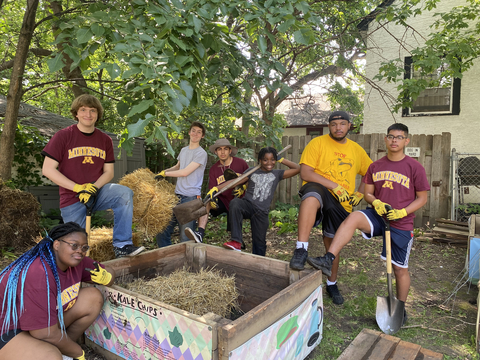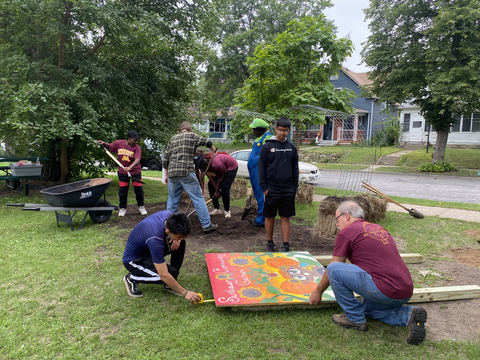Urban Agriculture Initiative transforms vacant lots into bright futures
When Sadaya Bronson, 18, joined a team of six other youth leaders as a summer intern with University of Minnesota Extension, she did not know what to expect. “We all came from different schools and neighborhoods,” she says. “There were people I had never seen before.”
By the end of the summer of 2022, Sadaya found herself part of a team dedicated to “not only caring for gardens but caring for the community.”
At the 6th Street and West Broadway neighborhoods in Minneapolis, gardens were bursting with squash, strawberries, tomatoes, peppers, kale, garlic, lemon balm, chamomile, mint and flowers.
It’s hard to believe that just over a year ago, these thriving plots sat as vacant lots.
Formed in collaboration between Extension, Hennepin County and community partners, the Urban Agriculture Initiative develops vacant lots into community gardens while creating a learning space for youth and residents to connect with the broader community.
From rooftop gardens to vertical farms to growing produce on vacant lots, urban agriculture not only creates pathways for greater food access, but fosters community building, closer neighborhood ties, physical and mental wellbeing, and educational opportunities.
“We are not only making lots more aesthetically pleasing and growing food in a garden,” says Craig Taylor, Extension regional director. “We are connecting and bringing power back to the community.”
Rooted in youth and community
The Urban Agriculture Initiative grows out of relationships cultivated over many years through northside 4-H Youth Development programs in agriculture and STEM led by Extension educators based at the Robert J. Jones Urban Research and Outreach-Engagement Center, such as Amie Mondl.
It also draws on expertise from Extension Master Gardener volunteers, agriculture educators, and health and
nutrition educators. But Extension staff aren’t the only ones bringing their knowledge to the table.
“The project is entirely collaborative and thrives with Extension SNAP-Ed’s* place-based core value,” says Sharmyn Phipps, SNAP-Ed regional coordinator. “That means communities’ voices are heard and are a part of what is taking place.”
Learning and flourishing
Sheronda Orridge and Elba Negron, community mentors living in the Broadway and 6th Street neighborhoods, are two such collaborators. During the summer of 2022, they guided a group of youth interns who named themselves the ‘Gardens for Change Crew.’
Taking youth on field trips to local farms, markets, gardens and even the state Capitol, Orridge – who has a Ph.D. in holistic life coaching – was impressed with the group’s leadership skills. “They wanted to learn and they wanted to teach,” she says.
Growing gardens presents opportunities to work across generations. Working alongside Extension Master Gardener volunteers as well as SNAP-Ed and EFNEP** educators, the young people learned how to design garden spaces and make nutritious foods like salsa and pesto.
Sadaya, who also participates with Extension through 4-H, describes the project as a “new opening and beginning” to learn, explore and discover her passions and aspirations.
Sharing her talent for art, Sadaya led a workshop to paint a sign for the 6th Street garden, renaming it the Sunflower Community Garden. Other youth led lessons on surviving in the wilderness, fixing bikes, getting good sleep, meditating and more.
Community mentors encourage youth to openly be themselves and share what’s in their hearts and on their minds, touching on topics about identity, belonging and future aspirations.
“Each morning we started doing a thing called poetry gumbo,” says Orridge. “We would start with a title and each person would write two lines and we would read it all together.”
Moments like these have inspired Sadaya in her everyday life. “I learned how to write down how I feel and that my words are powerful,” she says. “I use journaling to express myself and make a story about the person I want to be.”
Gathering to grow
Spending time growing their skills and the garden, youth leaders set out to take care of the community by helping neighbors with yard projects. Community partners like Sisters’ Camelot joined the team in inviting neighbors to gather and enjoy nutritious meals. Visitors took home fresh produce and seedlings, and helped plant the garden.
When Bridie Musser, the mother of a youth leader named Ben, noticed her son was building a garden in their back yard, she was eager to learn more about the project that “has changed his life and focus.” Attending gardening events with Ben, she has enjoyed connecting with the project team, residents from the neighborhood and Extension.
“The community is more engaged,” says Taylor. “I’m excited for this upcoming season and to continue watching the gardens and community grow.”
* Supplemental Nutrition Assistance Program Education
** Expanded Food and Nutrition Education Program
Permission is granted to news media to republish our news articles with credit to University of Minnesota Extension. Images also may be republished; please check for specific photographer credits or limited use restrictions in the photo title.




